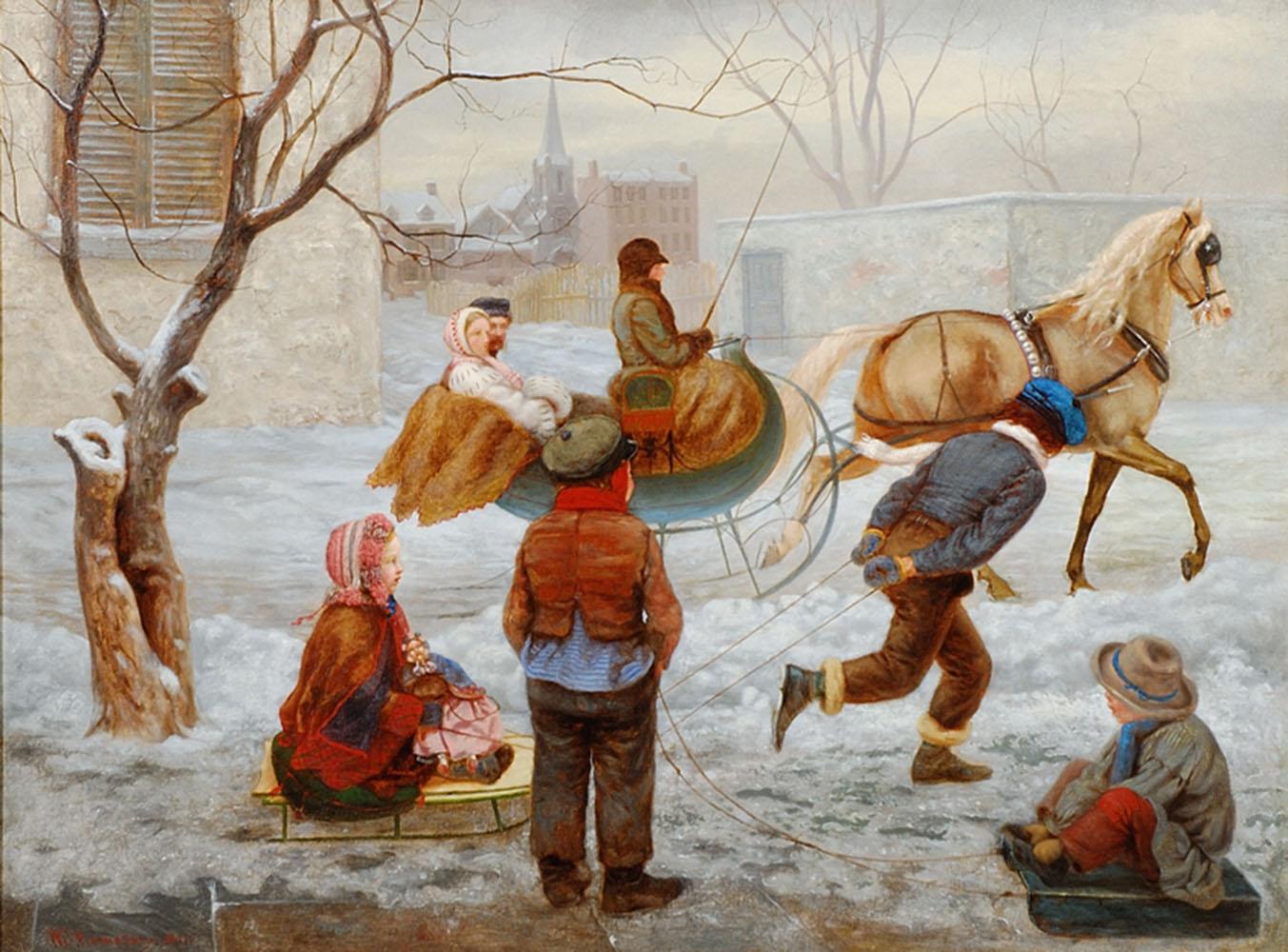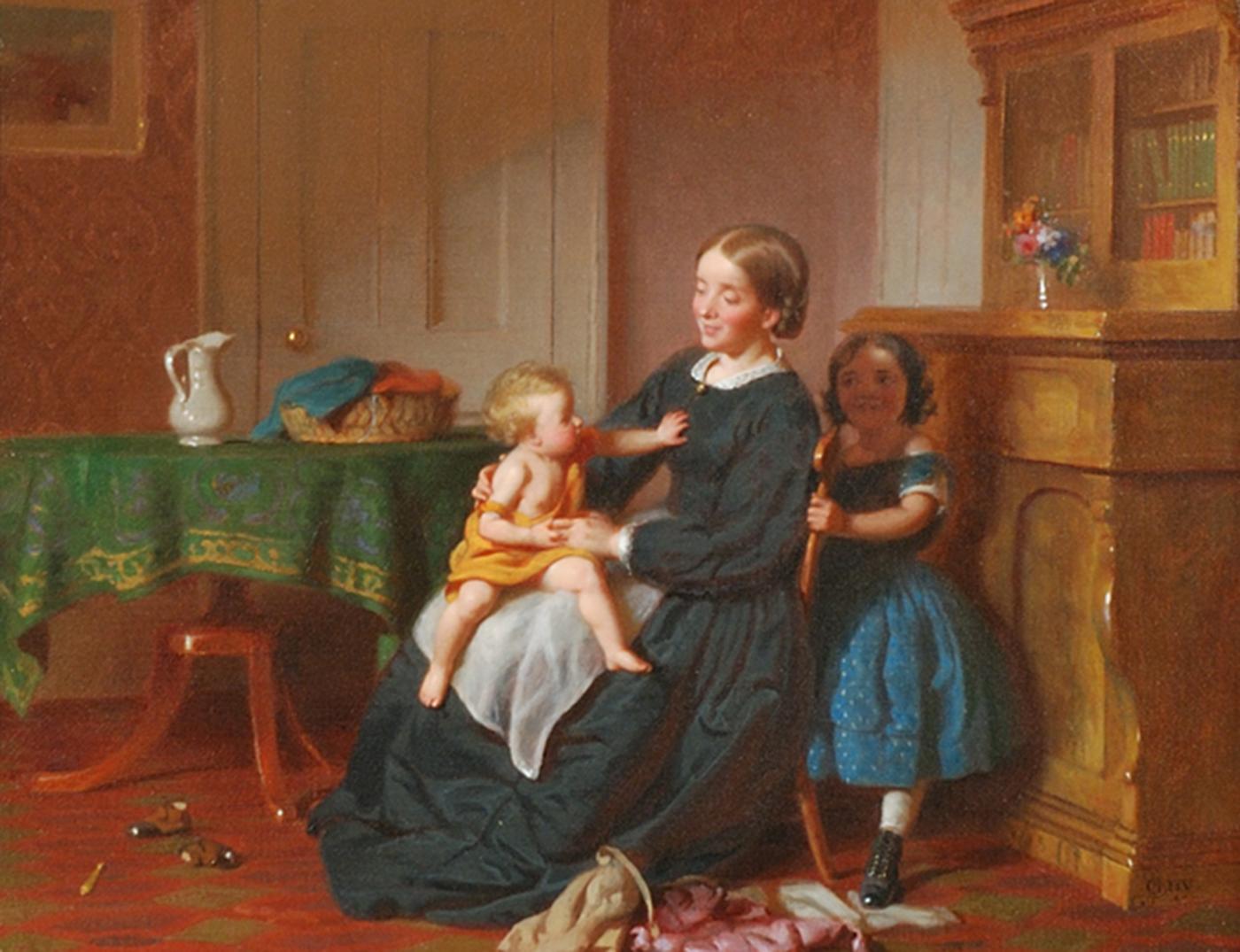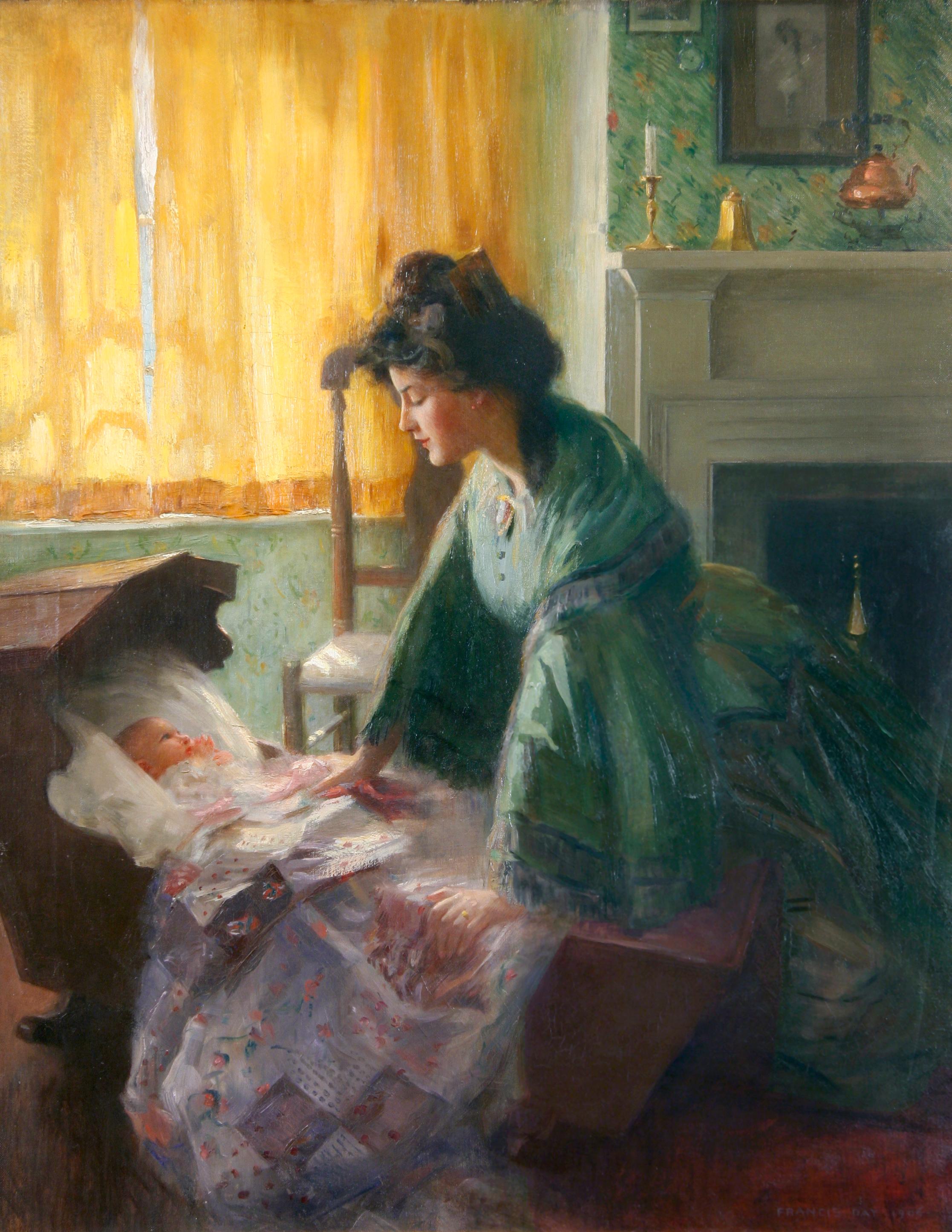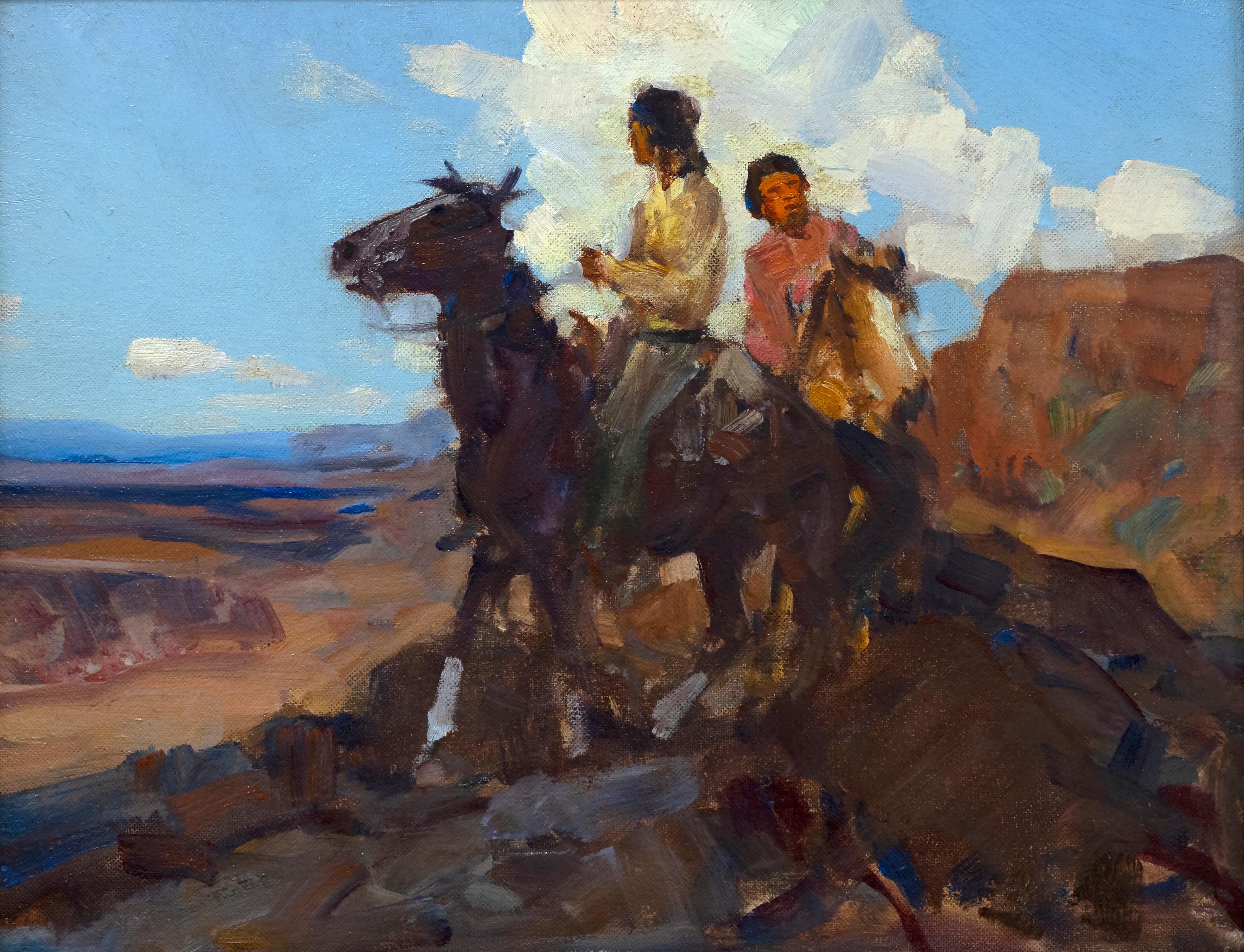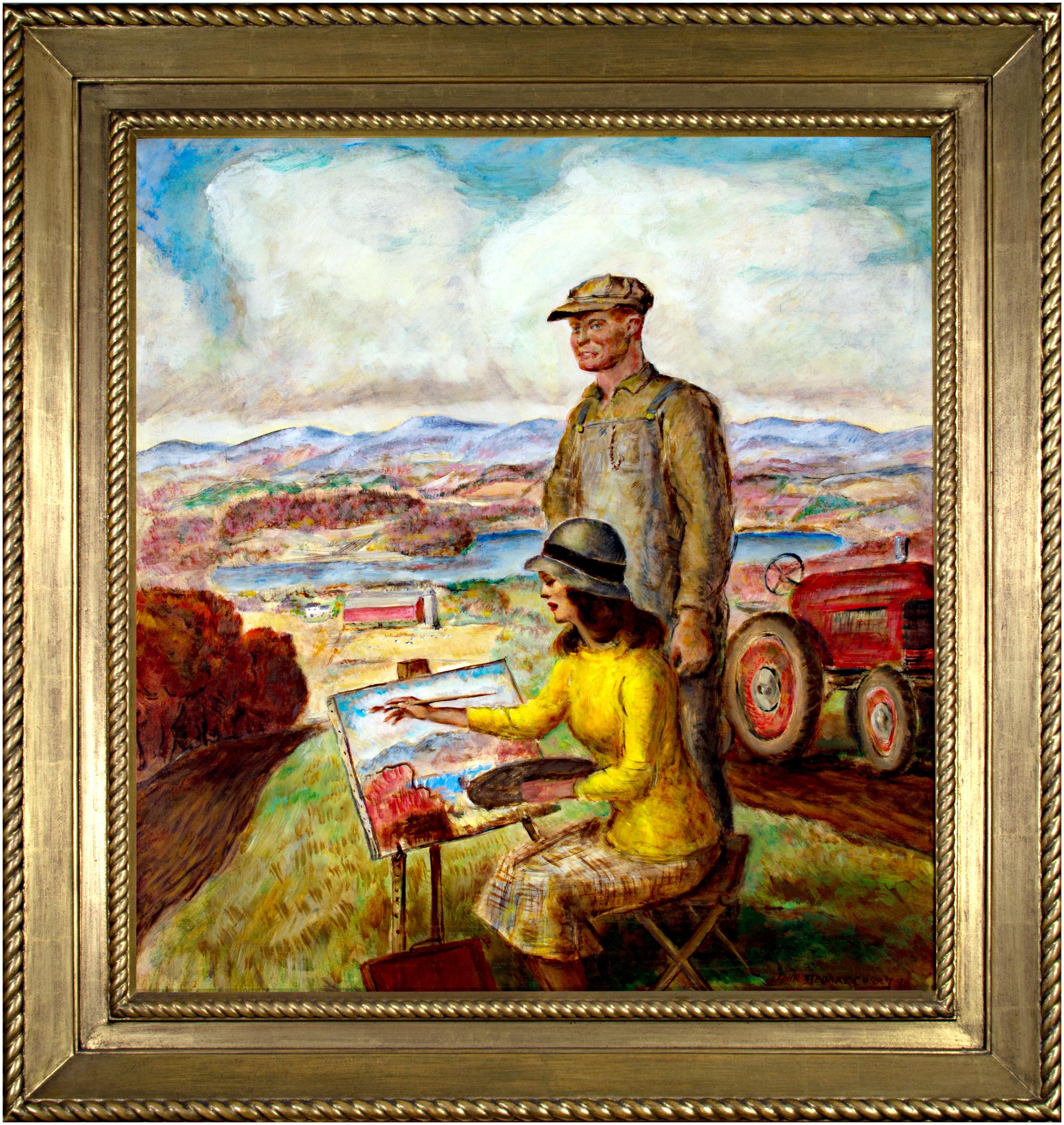Items Similar to Unique Painting By Albert Pels WPA Artist!
Want more images or videos?
Request additional images or videos from the seller
1 of 6
Albert PelsUnique Painting By Albert Pels WPA Artist!
About the Item
Albert Pels (1910-1998)
Painting of a group of figures, c. 20th century.
12 x 16 in.
Framed dimensions: 19 1/2 x 23 1/4 in.
Albert Pels was an art educator and painter of figures, genre scenes, urban and rural images, and illustration. He also did murals and worked in the mediums of oil, fresco, and watercolor. He was born on May 7, 1910, in Cincinnati, Ohio and died at the age of eighty-eight on January 25, 1998 in New York City. Albert Pels was the son of Samuel and Frieda Pels. He had two children, Joan Barbara and Richard J.A. with his first wife Gertrude Ethel Jaeckel. He later married Yolanda Zemfler, a painter of impressionist art.
While in Ohio, Pels attended the Cincinnati Art Academy in 1931 where he won several scholarships. After moving to New York, he continued his education at the Art Students League, Beaux Arts and the American School. At the Art Students League, Pels studied under Thomas Hart Benton, Kenneth Hayes Miller, and Alexander Brook. Under the tutelage of these mentors, Pels evolved his technique and style.
Pels was a member of the National Society of Mural Painters, the Salmagundi Club, and the Society of Independent Artists. He was on the board of directors of the Arts Students League in 1939, as well as, on the board the WPA Artists. One of the most important murals done by Albert Pels was for the Normal, Illinois, Post Office's lobby, which was a product of an assignment under the Section of Fine Arts. Unlike the WPA, artists in the Section of Fine Arts had to compete for the individual projects. The mural is entitled Development of the State Normal School. Pels chose the subject of the Normal Schools, which were colleges that specialized in the education of teachers.
Pels took his sculptural approach even further in his exhibition at the Laurel Gallery in Jan. 1949, where his figures seemed to pop out from the background creating a trompe l'oeil effect. Pels continued to embrace this sculptural style, evident in his subsequent exhibitions, such as his October 7th, 1949 show at Arthur Brown's Gallery in New York City.
Albert Pels had also shown in a number of additional galleries, museums, and one-man exhibitions. Some of them included the Macbeth Galleries, 1939; Babcock Gallery, 1941, 1945 - 46, 1949; Pulitzer Gallery, 1951; International Gallery, 1953; Laurel Gallery, 1955; Cincinnati Museum; Denver Museum; Butler Art Institute, Youngstown, Ohio; and Rachel Davis Fine Arts, Cleveland, 1996.
He exhibited in group shows at the Babcock Gallery, New York City; Albany Museum, Albany New York; Whitney Museum of American Art, New York City; Philadelphia Museum, P.A.; Butler Art Institute; Art Students League; and Southern Art Museum.
Later in his career, Pels founded the Albert Pels Art School in New York City at 71 W. 71 Street. He held classes in drawing, painting, commercial art, fashion, and cartooning for all ages and levels of study. He was the director until the late 1980's when it was sold.
Written and submitted June 2007 by Jeanette Hendler, Art Professional, New York City. The information is from her personal interview with the artist.
- Creator:Albert Pels (1910-1998, American)
- Dimensions:Height: 12 in (30.48 cm)Width: 16 in (40.64 cm)
- Medium:
- Movement & Style:
- Period:
- Condition:
- Gallery Location:Larchmont, NY
- Reference Number:1stDibs: LU2211211410182
Albert Pels
Albert Pels was an art educator and painter of figures, genre scenes, urban and rural images, and illustration. He also did murals and worked in the mediums of oil, fresco, and watercolor. He was born on May 7, 1910, in Cincinnati, Ohio and died at the age of eighty-eight on January 25, 1998 in New York City. Albert Pels was the son of Samuel and Frieda Pels. He had two children, Joan Barbara and Richard J.A. with his first wife Gertrude Ethel Jaeckel. He later married Yolanda Zemfler, a painter of impressionist art. While in Ohio, Pels attended the Cincinnati Art Academy in 1931 where he won several scholarships. After moving to New York, he continued his education at the Art Students League, Beaux Arts and the American School. At the Art Students League, Pels studied under Thomas Hart Benton, Kenneth Hayes Miller, and Alexander Brook. Under the tutelage of these mentors, Pels evolved his technique and style. Pels was a member of the National Society of Mural Painters, the Salmagundi Club, and the Society of Independent Artists. He was on the board of directors of the Arts Students League in 1939, as well as, on the board the WPA Artists. One of the most important murals done by Albert Pels was for the Normal, Illinois, Post Office's lobby, which was a product of an assignment under the Section of Fine Arts. Unlike the WPA, artists in the Section of Fine Arts had to compete for the individual projects. The mural is entitled Development of the State Normal School. Pels chose the subject of the Normal Schools, which were colleges that specialized in the education of teachers. Pels took his sculptural approach even further in his exhibition at the Laurel Gallery in Jan. 1949, where his figures seemed to pop out from the background creating a trompe l'oeil effect. Pels continued to embrace this sculptural style, evident in his subsequent exhibitions, such as his October 7th, 1949 show at Arthur Brown's Gallery in New York City. Albert Pels had also shown in a number of additional galleries, museums, and one-man exhibitions. Some of them included the Macbeth Galleries, 1939; Babcock Gallery, 1941, 1945 - 46, 1949; Pulitzer Gallery, 1951; International Gallery, 1953; Laurel Gallery, 1955; Cincinnati Museum; Denver Museum; Butler Art Institute, Youngstown, Ohio; and Rachel Davis Fine Arts, Cleveland, 1996. He exhibited in group shows at the Babcock Gallery, New York City; Albany Museum, Albany New York; Whitney Museum of American Art, New York City; Philadelphia Museum, P.A.; Butler Art Institute; Art Students League; and Southern Art Museum. Later in his career, Pels founded the Albert Pels Art School in New York City at 71 W. 71 Street. He held classes in drawing, painting, commercial art, fashion, and cartooning for all ages and levels of study. He was the director until the late 1980's when it was sold.
About the Seller
5.0
Gold Seller
These expertly vetted sellers are highly rated and consistently exceed customer expectations.
1stDibs seller since 2022
41 sales on 1stDibs
Typical response time: 1 hour
- ShippingRetrieving quote...Ships From: Larchmont, NY
- Return PolicyA return for this item may be initiated within 14 days of delivery.
More From This SellerView All
- Eugene Meeks English oil painting of a woman at a well titled "Roma", dated 1871Located in Larchmont, NYAntique Guy Meeks oil painting of a woman at a well. Signed lower right: G Meeks, Roma, 1871 Framed dimensions: 24 1/2 x 21 in.Category
Early 20th Century American Realist Figurative Paintings
MaterialsCanvas, Oil
- Portrait of Juliet Hyneman by American Artist Herman HynemanBy Herman HynemanLocated in Larchmont, NYPortrait of Juliet Hyneman by Jewish American artist Herman N. Hyneman Signature lower left Framed dimensions: 25 1/2 x 21 1/2 in. The following is from Peter Jung who credits "a friend named Jeff Gold on Long Island." Herman N. Hyneman (1849 - 1907) was born in 1849 to one of the most prominent Jewish families in Philadelphia. Unlike most Jewish families of the time, his embraced and encouraged his artistic talent. In 1874, Hyneman followed his first cousin Moses Ezekiel...Category
Late 19th Century American Realist Figurative Paintings
MaterialsOil
- American Portrait of the Artist's Wife by Herman HynemanBy Herman HynemanLocated in Larchmont, NYHerman Hyneman (1849-1907) Portrait of the Artist's Wife, c. late 19th century Oil on canvas 21 1/2 x 29 1/2 in. Framed: 27 1/2 x 35 1/4 in. The following is from Peter Jung who credits "a friend named Jeff Gold on Long Island." Herman N. Hyneman (1849 - 1907) was born in 1849 to one of the most prominent Jewish families in Philadelphia. Unlike most Jewish families of the time, his embraced and encouraged his artistic talent. In 1874, Hyneman followed his first cousin Moses Ezekiel, National Academy member, to Europe to study. They first went to Germany and then to France where Hyneman began eight years of study with Leon Bonnat, the French Master. In Paris, the twenty-five year old Hyneman resided in a studio building at 75 Boulevard Clichy, with expatriates Frederic Arthur Bridgeman, Charles Sprague Pearce, Milne Ramsey, and Edwin Blashfield. Hyneman was clearly exposed to the works of these more experienced artists, as well as that of Walter Gay. In 1879, one of Hyneman's genre paintings, entitled "Desdemona", was accepted into the Paris Salon. That painting received favorable reviews both in Europe, and later in Philadlephia where it was exhibited alongside the works of other Philadelphia Artists exhibiting at the Salon that included Thomas Eakins, Pearce, Edward May...Category
Late 19th Century American Realist Figurative Paintings
MaterialsOil
- RabbisBy Mane KatzLocated in Larchmont, NYMANE-KATZ RABBIS, c. 1935 Oil on canvas 18 H. x 14 W. 1/2 in. (45.5 x 35.8 cm.) Signed PROVENANCE Dominion Gallery, Montreal Christies, New York, November 04, 1982. Lot 177: $11,000 Private Collection, New Jersey, 1982-2021 Estate of the above, 2021. Raised in an orthodox Jewish family in Russia, Mane-Katz was born in the Ukraine and became an early 20th-century artist, known especially for portraits and paintings with Jewish themes. From childhood, he had been influenced by stories of Jewish mysticism, which was reflected in his paintings. He had a peripatetic life between Russia, France, Israel, and America. He first studied art in Kiev at the Beaux Arts Academy, and in 1913, went to Paris where he associated with Chaim Soutine and Marc Chagall and continued his art studies there at the Beaux Arts Academy. During World War I, he tried to join the Foreign Legion but was rejected because he was too short. He went back in Russia again, this time joining the Soviet Revolution but rejected the cause because he was so horrified by Josef Stalin. He worked briefly for the Russian ballets, and in 1921, he returned to Paris where in 1927 he took French citizenship. For the next twelve years, he traveled widely, showing his art work and doing many paintings. In 1939, as World War II was breaking out, he was drafted by the French and then was taken prisoner by the Germans. He escaped and went to the United States and remained there until 1945, exhibiting his paintings at Katia Granoff Gallery and Wildenstein Gallery. After the war, he returned to Paris where he had exhibited in the Salons. In Paris to the end of his career, he worked happily, painting hundreds of portraits of rabbis...Category
Early 20th Century Fauvist Figurative Paintings
MaterialsCanvas, Oil
- James Allen St. John, Portait of a LadyLocated in Larchmont, NYJames Allen St. John (American, 1872-1957) Portrait of a lady, Early 20th Century 7 3/4 x 5 1/4 in. Framed dimensions: 17 1/2 x 15 x 3in. James Allen Saint John was born in Chicago,...Category
Early 20th Century American Impressionist Figurative Paintings
MaterialsCanvas, Oil
- Original Leonard Creo Painting of Boys on a Jungle GymLocated in Larchmont, NYLeonard Creo (American, 1923-2019) Children on Jungle Gym, c. 20th century Oil on canvas 12 x 11 3/4 in. Signed lower right: Creo - Another version of ...Category
20th Century Modern Figurative Paintings
MaterialsCanvas, Oil
You May Also Like
- The RaceBy William John HennessyLocated in New York, NYWilliam John Hennessy was born in Ireland. He came to America in 1849 with his mother and brother a year after his father had fled their homeland after taking part in the unsuccessful Young Ireland Party uprising. The Hennessys settled in New York, and when young William came of age, he decided upon a career as an artist. At the age of fifteen, he enrolled at the National Academy of Design, where he learned to draw from the antique, and the following year he was granted admission to the Academy’s life-drawing class. Hennessy first exhibited at the National Academy in 1857, starting a continuous run of appearances in their annuals that lasted until 1870, when he expatriated himself to Europe. During his time in America, Hennessy was principally known as a genre painter and prolific illustrator for such publications as Harper’s Weekly and a number of books, including illustrated works of William Cullen Bryant...Category
19th Century American Realist Figurative Paintings
MaterialsCanvas, Oil
- Peek-a-BooBy Seymour Joseph GuyLocated in New York, NYIn the latter half of the nineteenth century and into the first decade of the twentieth, New York City art aficionados could count on finding recent work of Seymour Joseph Guy hanging on the walls of the city’s major galleries. Primarily a genre artist, but also a portraitist, between 1859 and 1908 Guy showed more than seventy works at the National Academy of Design. From 1871 to 1903 he contributed over seventy times to exhibitions at the Century Club. From 1864 to 1887, he sent about forty pictures to the Brooklyn Art Association. A good number of these works were already privately owned; they served as advertisements for other pictures that were available for sale. Some pictures were shown multiple times in the same or different venues. Guy was as easy to find as his canvases were omnipresent. Though he lived at first in Brooklyn with his family and then in New Jersey, from 1863 to his death in 1910 he maintained a studio at the Artist’s Studio Building at 55 West 10th Street, a location that was, for much of that period, the center of the New York City art world. Guy’s path to a successful career as an artist was by no means smooth or even likely. Born in Greenwich, England, he was orphaned at the age of nine. His early interest in art was discouraged by his legal guardian, who wanted a more settled trade for the young man. Only after the guardian also died was Guy free to pursue his intention of becoming an artist. The details of Guy’s early training in art are unclear. His first teacher is believed to have been Thomas Buttersworth...Category
19th Century American Realist Figurative Paintings
MaterialsCanvas, Oil
- Light of LoveLocated in Washington, DCExhibited: National Academy of Design, New York, 1906 (as no. 101) Art Institute of Chicago, 1908 (as no. 74)Category
Early 1900s American Realist Figurative Paintings
MaterialsCanvas, Oil
- ScoutingBy Frank Tenney JohnsonLocated in Palm Desert, CA"Scouting" is an oil on canvas painting by Frank Tenney Johnson. The framed piece measures 23 3/4 x 27 3/4 x 3 1/4 inches. Johnson was well-known for his work of the American west, particularly for his portrayal of cowboys at night, lit by moonlight. Johnson utilized knives and fingers when painting, so his work is recognizable for its distinctive marks. Provenance: Biltmore Galleries, Scottsdale...Category
Early 20th Century American Realist Landscape Paintings
MaterialsCanvas, Oil
- 'Sketching Wisconsin' original oil painting, SignedBy John Steuart CurryLocated in Milwaukee, WIJohn Steuart Curry "Sketching Wisconsin," 1946 oil on canvas 31.13 x 28 inches, canvas 39.75 x 36.75 x 2.5 inches, frame Signed and dated lower right Overall excellent condition Presented in a 24-karat gold leaf hand-carved wood frame John Steuart Curry (1897-1946) was an American regionalist painter active during the Great Depression and into World War II. He was born in Kansas on his family’s farm but went on to study art in Chicago, Paris and New York as young man. In Paris, he was exposed to the work of masters such as Peter Paul Rubens, Eugène Delacroix and Jacques-Louis David. As he matured, his work showed the influence of these masters, especially in his compositional decisions. Like the two other Midwestern regionalist artists that are most often grouped with him, Grant Wood (American, 1891-1942) and Thomas Hart Benton (American, 1889-1975), Curry was interested in representational works containing distinctly American subject matter. This was contrary to the popular art at the time, which was moving closer and closer to abstraction and individual expression. Sketching Wisconsin is an oil painting completed in 1946, the last year of John Steuart Curry’s life, during which time he was the artist-in-residence at the University of Wisconsin in Madison. The painting is significant in Curry’s body of work both as a very revealing self-portrait, and as a landscape that clearly and sensitively depicts the scenery of southern Wisconsin near Madison. It is also a portrait of the artist’s second wife, Kathleen Gould Curry, and is unique in that it contains a ‘picture within a picture,’ a compositional element that many early painting masters used to draw the eye of the viewer. This particular artwork adds a new twist to this theme: Curry’s wife is creating essentially the same painting the viewer is looking at when viewing Sketching Wisconsin. The triangular composition of the figures in the foreground immediately brings focus to a younger Curry, whose head penetrates the horizon line and whose gaze looks out towards the viewer. The eye then moves down to Mrs. Curry, who, seated on a folding stool and with her hand raised to paint the canvas on the easel before her, anchors the triangular composition. The shape is repeated in the legs of the stool and the easel. Behind the two figures, stripes of furrowed fields fall away gently down the hillside to a farmstead and small lake below. Beyond the lake, patches of field and forest rise and fall into the distance, and eventually give way to blue hills. Here, Curry has subverted the traditional artist’s self-portrait by portraying himself as a farmer first and an artist second. He rejects what he sees as an elitist art world of the East Coast and Europe. In this self-portrait he depicts himself without any pretense or the instruments of his profession and with a red tractor standing in the field behind him as if he was taking a break from the field work. Here, Curry’s wife symbolizes John Steuart Curry’s identity as an artist. Compared with a self-portrait of the artist completed a decade earlier, this work shows a marked departure from how the artist previously presented and viewed himself. In the earlier portrait, Curry depicted himself in the studio with brushes in hand, and with some of his more recognizable and successful canvases behind him. But in Sketching Wisconsin, Curry has taken himself out of the studio and into the field, indicating a shift in the artist’s self-conception. Sketching Wisconsin’s rural subject also expresses Curry’s populist ideals, that art could be relevant to anyone. This followed the broad educational objectives of UW’s artist-in-residence program. Curry was appointed to his position at the University of Wisconsin in 1937 and was the first person to hold any such position in the country, the purpose of which was to serve as an educational resource to the people of the state. He embraced his role at the University with zeal and not only opened the doors of his campus studio in the School of Agriculture to the community, but also spent a great deal of time traveling around the state of Wisconsin to visit rural artists who could benefit from his expertise. It was during his ten years in the program that Curry was able to put into practice his belief that art should be meaningful to the rural populace. However, during this time he also struggled with public criticism, as the dominant forces of the art market were moving away from representation. Perhaps it was Curry’s desire for public acceptance during the latter part of his career that caused him to portray himself as an Everyman in Sketching Wisconsin. Beyond its importance as a portrait of the artist, Sketching Wisconsin is also a detailed and sensitive landscape that shows us Curry’s deep personal connection to his environment. The landscape here can be compared to Wisconsin Landscape of 1938-39 (the Metropolitan Museum of Art), which presents a similar tableau of rolling hills with a patchwork of fields. Like Wisconsin Landscape, this is an incredibly detailed and expressive depiction of a place close to the artist’s heart. This expressive landscape is certainly the result of many hours spent sketching people, animals, weather conditions and topography of Wisconsin as Curry traveled around the state. The backdrop of undulating hills and the sweeping horizon, and the emotions evoked by it, are emphatically recognizable as the ‘driftless’ area of south-central Wisconsin. But while the Metropolitan’s Wisconsin Landscape conveys a sense of uncertainty or foreboding with its dramatic spring cloudscape and alternating bands of light and dark, Sketching Wisconsin has a warm and reflective mood. The colors of the foliage indicate that it is late summer and Curry seems to look out at the viewer approvingly, as if satisfied with the fertile ground surrounding him. The landscape in Sketching Wisconsin is also revealing of what became one of Curry’s passions while artist-in-residence at UW’s School of Agriculture – soil conservation. When Curry was a child in Kansas, he saw his father almost lose his farm and its soil to the erosion of The Dust Bowl. Therefore, he was very enthusiastic about ideas from UW’s School of Agriculture on soil conservation methods being used on Wisconsin farms. In Sketching Wisconsin, we see evidence of crop rotation methods in the terraced stripes of fields leading down the hillside away from the Curry’s and in how they alternate between cultivated and fallow fields. Overall, Sketching Wisconsin has a warm, reflective, and comfortably pastoral atmosphere, and the perceived shift in Curry’s self-image that is evident in the portrait is a positive one. After his rise to favor in the art world in the 1930’s, and then rejection from it due to the strong beliefs presented in his art, Curry is satisfied and proud to be farmer in this self-portrait. Curry suffered from high blood...Category
1940s American Realist Figurative Paintings
MaterialsOil, Canvas
- Antique American Oil Painting Portrait Young Woman Necklace Period Frame RareLocated in Buffalo, NYA beautiful and rare antique American portrait of a young woman in a stunning period frame, likely original to the piece. Unsigned but beaut...Category
1890s American Realist Portrait Paintings
MaterialsOil, Canvas
Recently Viewed
View AllMore Ways To Browse
Philadelphia Fine Artist
Illinois Artists
Illinois Artist
Southern Artists Oil Paintings
Ohio Artist
Cartoon Painting
Albert York
Albert Painter
C Manning Artists Paintings
Artist Cleveland
Albert Oil Painting
American Genre Painting
19 By 23
Art Wpa
Wpa Art
Rural America Painting
American Southern School
19 Century American Artists
